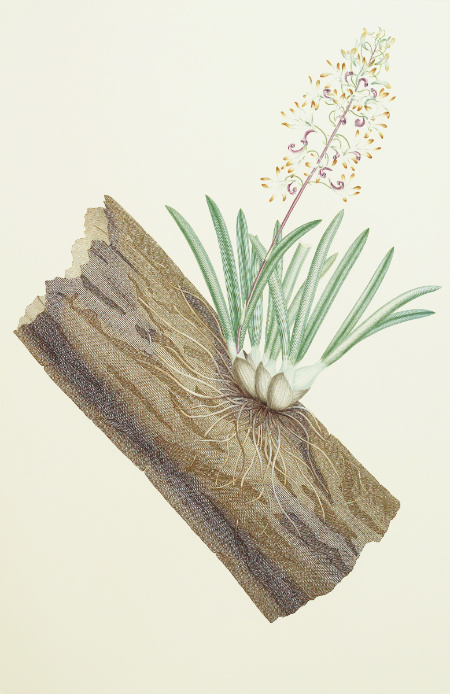
SYDNEY PARKINSON and FREDERICK POLYDORE NODDER (artists)
‘Plate 315. Dendrobium Canaliculatum, R. Brown, Epidendrum canaliculatum (Orchidaceae)’
London: Alecto Historical Editions in association with the British Museum (Natural History), 1980-1990
Engraving by Daniel MacKenzie, printed à la poupée by Alecto Historical Editions
Limited to 116 impressions, this no. 3 of 3 for exhibition and numbered ‘EP 3/3’
❧ DENDROBIUM CANALICULATUM, R. BROWN, EPIDENDRUM CANALICULATUM (ORCHIDACEAE)
Species found at Endeavour River, Australia
17 June – 4 August 1770
Remarkably, at the mouth of Endeavour River, ‘Banks and Solander searched the whole neighbourhood thoroughly for plants and obtained a harvest of new species exceeding in number even those gathered at Botany Bay’. It is rather surprising, then, that – in contrast to Botany Bay – ‘the Endeavour River remained virtually unknown for many years more, with its plants available only in the collections of Banks and Solander’ (Stearn, ‘A Royal Society Appointment’, p. 111).
This ‘tea tree orchid’, Dendrobium Canaliculatum, is a striking example of a plant discovered at Endeavour River but not communicated widely: it would not be described scientifically for another forty years, when it appeared in Robert Brown’s Prodromus Florae Novae Hollandiae et Insulae Van Diemen (London, 1810, vol. 1, p. 333).
A sweetly scented miniature orchid, the Dendrobium Canaliculatum naturally grows on the bark of gum or melaleuca trees, and blooms from mid-winter to mid-spring; its cultivation, however, appears to be very difficult. According to an article of 1868, ‘[t]he bulbous stems, after being deprived of the old leaves are eatable’ (John Crawford, ‘On the Vegetable and Animal Food of the Natives of Australia in reference to social position . . . ’, Transactions of the Ethnological Society of London 6 N.S. (1868), pp. 112-122, at p. 114).
SPECIFICATIONS
The engravings are all of a very similar size, with platemarks of circa 457 x 305mm, and are printed on acid-free Somerset mould-made 300gsm paper manufactured by the Inveresk Paper Company. Each sheet is watermarked ‘AHE’, measures 724 x 556mm, and bears blind embossed stamps incorporating the publishers’ and printer’s chops, the copyright symbol, and date of publication; the initials of the individual printer, the plate number, and the edition number are recorded in pencil. The engravings are protected by a bifolium of acid-free Somerset mould-made 300gsm paper, cut to form a window mount on which is recorded the modern and Banksian names of the plant, the location and date of its collection and the name(s) of the artist and engraver.
This print accompanied by a certificate of limitation.
This print is no longer available.
© Type & Forme and Alecto Historical Editions/Trustees of the Natural History Museum 2020

